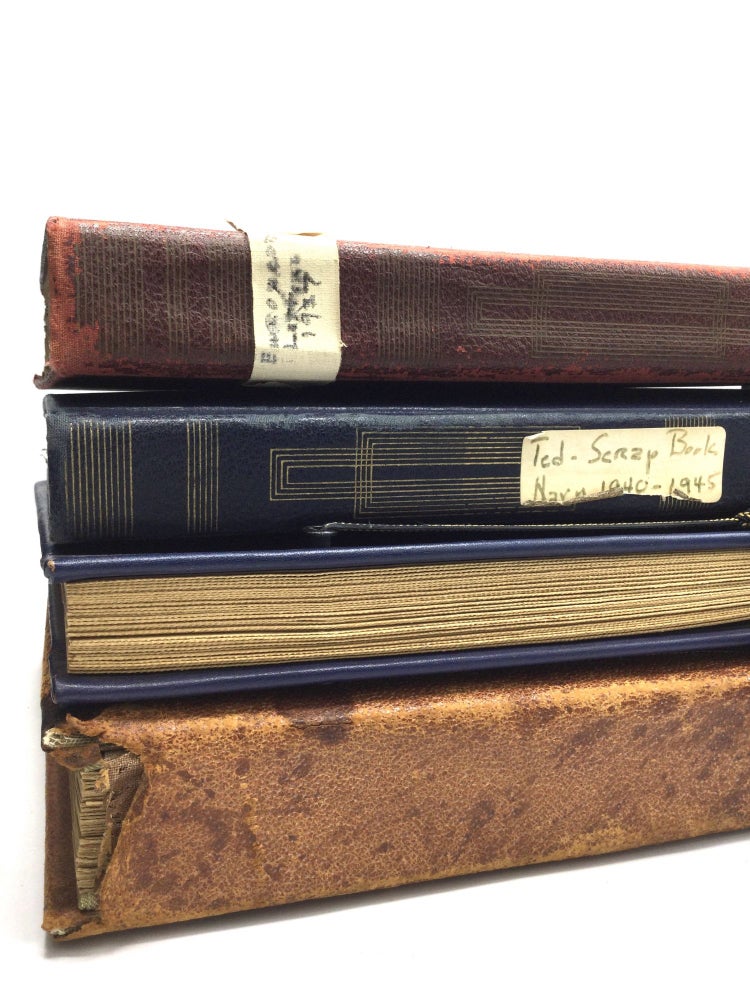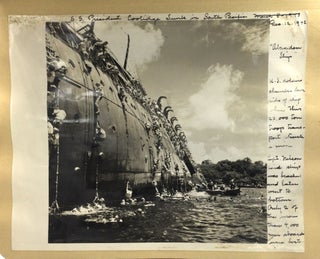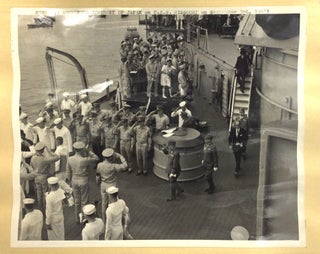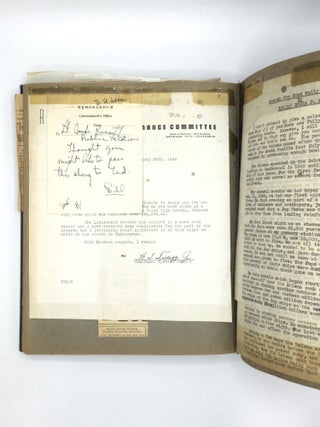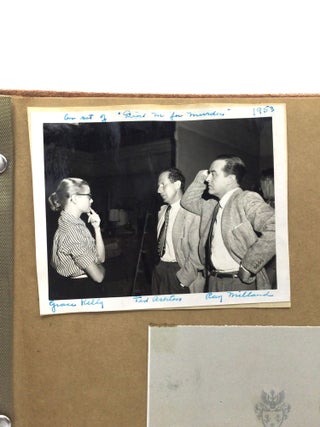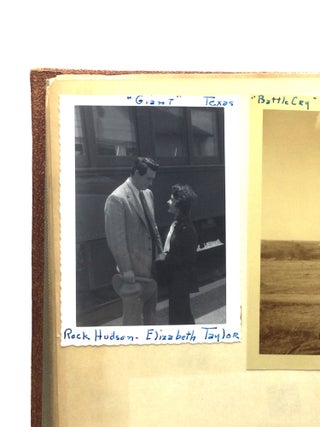SCRAPBOOKS OF A WAR HERO WHO BECAME A HOLLYWOOD PUBLICIST
A collection of scrapbooks containing photographs, ephemera, and memoirs written by Edwin Duden “Ted” Ashton (1914–2009), an American war hero and publicist for the film industry. Following his graduation from Princeton University, the New Jersey native embarked on a three-month tour of Europe, where he visited film studios and wrote about his impressions of the growing strength of Adolf Hitler in Germany.
The archive is comprised of four scrapbooks, which contain hundreds of original photographs, numerous newspaper clippings, and other pieces of ephemera, ranging from war commendations to theater programs, postcards, tickets, and brochures. One of the albums is dedicated to his 1937 trip to Europe and contains a remarkable 30-page typescript of approximately 15,000 words about his travels, written in the form of letters home to his mother. He sailed aboard the SS Queen Mary on June 9, 1937 and carried with him a letter from New Jersey Senator A. Harry Moore to the consular office, asking them to assist him with anything he needed. According to a newspaper clipping, Ashton was employed in the publicity department at Columbia Pictures in New York, but they gave him leave for the trip as he also planned to visit studios in England, France, Italy, Russia, Germany and Hungary. “To study not only productions methods but also publicity and promotion practice in the foreign film industry,” according to the story in the June 9, 1937 Hudson Dispatch.
In the typescript, Ashton wrote on Monday, June 21, 1937 that he spent the morning at the London offices of Columbia: “The reception I got was positively overwhelming. If I had been Harry Cohn in person, I could not have been received more cordially. I am getting several letters of introduction to some of the countries I am going to, none to Russia, however.”
During his stay, he attended a celebrated boxing match, attended the races at Ascot, took in matches at Wimbledon, spent a day at the Rothchild Mansion in Exbury lunching and playing tennis, visited the House of Commons and various other attractions, and dined with friends. On July 5, 1937 he visited Elstree Studio, where they were filming a musical picture and, in particular, scenes of seminude chorus girls: “I stayed very late and had a very pleasant afternoon. Gina Malo and Clare Luce are in the picture. One could talk on the set because none of the sound apparatus was being used. The singing and the principals and the tapping of the chorus girls’ feet had already been recorded in a special sound studio, and they mouthed the words or did their dance routines in time with the music or signing that was being played back to them. Interesting to watch.”
He wrote very little about his visit to Russia but the scrapbook contains a press clipping from the August 17, 1937 Hudson Dispatch newspaper, which published his report: “It is surprising to the visitor to find the women of Russia doing jobs that would be done by men in other countries. They work in the construction of buildings. They sweep the streets. They work in the trolleys and subways.”
On July 22, 1937, he traveled to Germany. “Hitler must have given the German people instructions to treat the visitor with the greatest consideration,” he wrote. “From the time the train first entered Germany everything has been done to make things as easy as possible for the tourist. No suitcases were opened for inspection.”
While visiting Germany, he spoke with a few people in the motion picture business and learned that there were few independent studios, as 85 percent of the industry was government controlled: “There are few American pictures imported at the present time as the Germans want the Americans to buy German pictures when they buy American pictures. They are willing to make English versions of the German pictures. Of course, the American companies are not anxious to buy German films.”
From Berlin, he traveled to Munich for a few days and then on to Salzburg, where he stayed with Florence von Poser, an old friend who owned Grubhof Castle. “Even in Austria Nazism is growing in power, I am afraid,” he wrote. “The Von Posers are very much pro Hitler. There are pictures of ‘Der Fuhrer’ all over the castle...”
He then traveled to Vienna, where he did some sightseeing and visited some film studios, which he felt were also under the influence of Germany. “To revert back to Germany for a few lines. I forgot to tell you my opinion of the country. As far as actually freedom is concerned, there is no more than there is in Russia,” he wrote. “Of course, the persecution of the Jews is no myth, as some Germans would like you to believe. No doubt there is a great deal of opposition to Hitler, but from a superficial inspection of Berlin and Munich, I am sorry to say that one is given the impression that Germany is going places. In Russia the guides liked to point out to you the way the Russians walk through the streets with a purpose. In Russia the purpose probably is to escape from the one room, in which they live with several other families. However, in Germany one does get the feeling that the Germans are going at things with a purpose – to be a really great country and that they will succeed. I hate to make this report, but it seems to be a fact.”
From Austria, he traveled to Budapest, Rome, and Venice and then on to Switzerland, where he stayed at several first-class resorts and played in tennis tournaments. His final days were spent in France before leaving September 23, 1937 on the S.S. Champlain.
Following his European adventure, Ashton returned to the United States and worked with the movie studios for two years before being drafted into the U.S. Navy. Two of the scrapbooks are dedicated to his military career. On July 21, 1942, he was assigned to the U.S.S. Helena, which had just undergone repairs resulting from the damage it received during the Japanese attack on Pearl Harbor. A 5 ½ page typescript taped into the album chronicles Ashton’s South Pacific cruise.
August 25, 1942: “Set foot on land for the first time since July 20th. The place was a small island, in peace times principally inhabited by the black natives with a few hundred whites,” he wrote. “Now the population of this group of islands is greatly augmented by Army, Navy and Marine personnel. The sailor on liberty seeks women and liquor. Neither are to be found here for the enlisted man. The officers are able to obtain drinks at the Officers’ Club, a room which resembles Kelly’s Pool Room in the slum section of the big city. I had one drink and spent the remainder of the few hours of liberty seeing what little there was to be seen. In town there were a few Chinese stores…my only purchase, strangely enough, was a cake of British soap. It brought back memories of more pleasant days in Hollywood.”
Ashton described the appearance of the natives on the island as darkly black, friendly and with large feet, noting they all went barefoot. He said they also dye their hair red. “They are not subject to the Anne Sheridan or Lana Turner influence, but to severe cases of lice. The red dye is supposed to kill the lice.” He also noted that the women had blackened teeth from chewing on beetle nut.
When not on duty, Ashton spent most of his time reading a wide variety of books. In December, he visited the little French village of Noumea, capital of the South Pacific island of New Caledonia. He found a little French restaurant that had just reopened following the food shortages.
Ashton’s ship, the Helena, was assigned to the forces participating in the Guadalcanal campaign in the South Pacific and took part in two major night battles and sunk Japanese vessels in October and November 1942. During her tour, she also escorted convoys carrying supplies and reinforcements to the Marines fighting on Guadalcanal and bombarded Japanese positions on the island and elsewhere in the Solomons.
Following the American victory on Guadalcanal in early 1943, Allied forces began preparations to advance along the Solomon chain, first targeting New Georgia. Helena took part in a series of preparatory attacks on the island through mid-1943. On July 6, while attempting to intercept a Japanese reinforcement squadron, Helena was torpedoed and sunk in the Battle of Kula Gulf. Most of her crew were picked up by a pair of destroyers and one group landed on New Georgia where they were evacuated the next day, but more than a hundred remained at sea for two days, ultimately making land on Japanese-occupied Vella Lavella. Fortunately for Ashton, he was transferred from the Helena days before it was sunk.
One of the albums about his military experiences contains a two-page typescript of a speech he gave on January 3, 1944 for the Lions Club of San Bruno.
“I have been asked to make a brief talk on a subject on which I like to speak: The U.S.S. Helena,” he wrote. “How do you feel when in Battle?” is a question frequently asked of the returning service man. My answer would be that, of course, I was scared. However, the fear is not as great as one would imagine considering the risk involved. Life at sea in wartime is not a normal one. Hence, one’s reactions are not always normal. In a way, one actually welcomes action to relieve the monotony of standing the same watch day after day.”
In addition to the speech, this album also includes dozens of newspaper clippings about the Helena and an 8” x 10” black and white photograph with a handwritten caption of U.S. Cruiser Helena at Pearl Harbor, December 7, 1941. The album also contains photographs, letters, and commendations Ashton received for his speaking tour in support of the war effort, including a copy of his speech for a bond rally in Redwood City in 1944, which raised $64,000.
A second scrapbook of 120 pages with Ashton’s name imprinted on the front contains documents along with twenty-seven 8” x 10” black and white photographs of his war experiences, along with another dozen smaller photographs. The images are captioned in ink, pasted in the scrapbook and include: two black and white portraits of Ashton in uniform, along with the military bars he received for his service in combat on the Helena and a press release about its history; a Japanese submarine brought to San Francisco; three smaller photographs of Admiral Nimitz’ visit to San Francisco City Hall in October 1945; San Bruno Naval Base in 1943; men rappelling down the side of the S.S. President Coolidge, sunk in the South Pacific on December 12, 1942 after it struck a mine; a Japanese task force smashed in the Battle of Guadalcanal, November 13-15, 1942; a Japanese torpedo bomber and U.S. ships off Guadalcanal in 1942; U.S.S. O’Brien damaged by Kamakazi plane off Okinawa in 1945; the surrender ceremony aboard the U.S.S. Missouri on September 3, 1945; U.S. ships at anchor in San Francisco Bay in September 1945; President Truman visiting San Francisco for a United Nations conference in May 1945; and the U.S.S. Saratoga passing under the golden gate as she leaves San Francisco for Pearl Harbor and then Bikini in the Marshall Islands, where she will be one of the target ships for the atomic test on May 1, 1946.
The final of the four scrapbooks in this collection are related to Ashton’s personal life and his career working as a publicist in Hollywood. There are more than 500 original, mostly black and white, photographs. Many are on movie sets with a smattering of images of his mother and sister, playing tennis, attending horses races, and visiting friends. Many of the images in the brown leather album are hand-captioned and some of the highlights include: a black and white snapshot of Grace Kelly from 1953 captioned Dial M for Murder; images from the 1957 film “No Time for Sergeants” including photographs of William Holden; photos of Ashton on location in Bishop, California for the filming of “The Jagged Edge”; a group of eight photos from the filming of the movie Daniel Boone in Kenab, Utah; photographs of television and radio announcer H.V. Kaltenborn’s 80th birthday; photographs from the filming of the movie Firecreek, including a few of Henry Fonda on horseback; photographs of Rock Hudson in Texas, where he was filming Giant with Elizabeth Taylor; and a group of 18 images dated April 1961 from the filming of “Lad, A Dog” with Peggy McKay and various animals on the Disney Ranch.
The final two pages of the 120-page album contain a two-page partial index, presumably created by Ashton. The materials are all in very good condition. Item #73709
Price: $3,500.00


